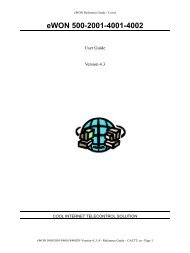eWON Family - eWON Support
eWON Family - eWON Support
eWON Family - eWON Support
You also want an ePaper? Increase the reach of your titles
YUMPU automatically turns print PDFs into web optimized ePapers that Google loves.
5 The <strong>eWON</strong> IO Servers<br />
5.1 Introduction<br />
General Reference Guide IO Servers Configuration<br />
This introduction repeats some information already introduced in chapter “Tag definition: Introduction” on page 67.<br />
An IO Server is the interface between a changing value and the <strong>eWON</strong> monitoring engine. It is a kind of driver. Any variable from any data source<br />
must have a common representation for all IO Servers in order to define common interface in the <strong>eWON</strong>.<br />
The data-source representation in the <strong>eWON</strong> uses 3 fields for the definition of a Tag:<br />
• The IO Server Name<br />
• The Topic name<br />
• The Item Name<br />
A Tag’s data-source will be uniquely identified with these 3 parameters:<br />
IO Server name:<br />
Topic Name:<br />
Item Name:<br />
Important note: For optimisation purpose, the <strong>eWON</strong> may disable the polling of “invalid tags” (See “IO Server Init” on page 86).<br />
5.2 IO servers setup<br />
Some of the IO servers are configurable.<br />
The IO setup window proposes a list of IO servers:<br />
Is a kind of driver name. For each IO Server there is a specific Topic Name and Item Name syntax.<br />
Example: MODBUS, EWON, MEM<br />
Is used to group items inside an IO Server, for example the memory IO Server uses the blank topic<br />
("") and the retentive topic ("ret"). All Tags of the MEM IO Server defined in the "ret" topic will have<br />
their value saved and restored when the <strong>eWON</strong> boots.<br />
All IO servers do not use a Topic Name. In that case the Topic Name field must be left empty.<br />
The item name is a string of characters; its syntax is specific to each IO Server.<br />
The Item Name describes the physical variable to monitor that uses the IO Server.<br />
For example, the MODBUS IO Server needs to poll registers or coils from a slave, so it uses an item name representation to<br />
define the register type, register address and slave address. (Example "40001,5" => Where 4 means "read write register",<br />
0001 is the register number and 5 is the slave Modbus address).<br />
Table 56: Tags data-source parameters<br />
Figure 71: <strong>eWON</strong> IO servers scrolling list<br />
Click on the Edit hyper link or select another IO server to display its edition window.<br />
There are 3 possible cases regarding the IO server configuration:<br />
• The IO server is not configurable<br />
• The IO server has a dedicated configuration page (ex: MODBUS, UNITE, NETMPI, DF1, ...)<br />
• The IO server uses the standard IO server configuration page.<br />
RG-001-0-EN ver 1.6 <strong>eWON</strong>® - 22/06/2009 - ©ACT'L sa Page 85





